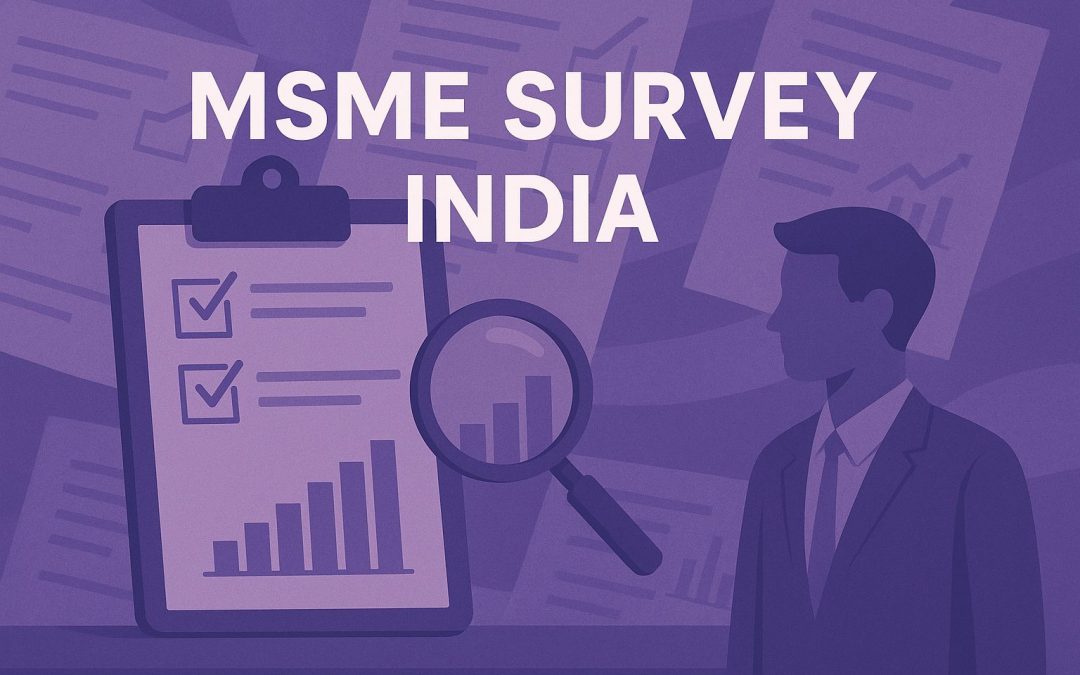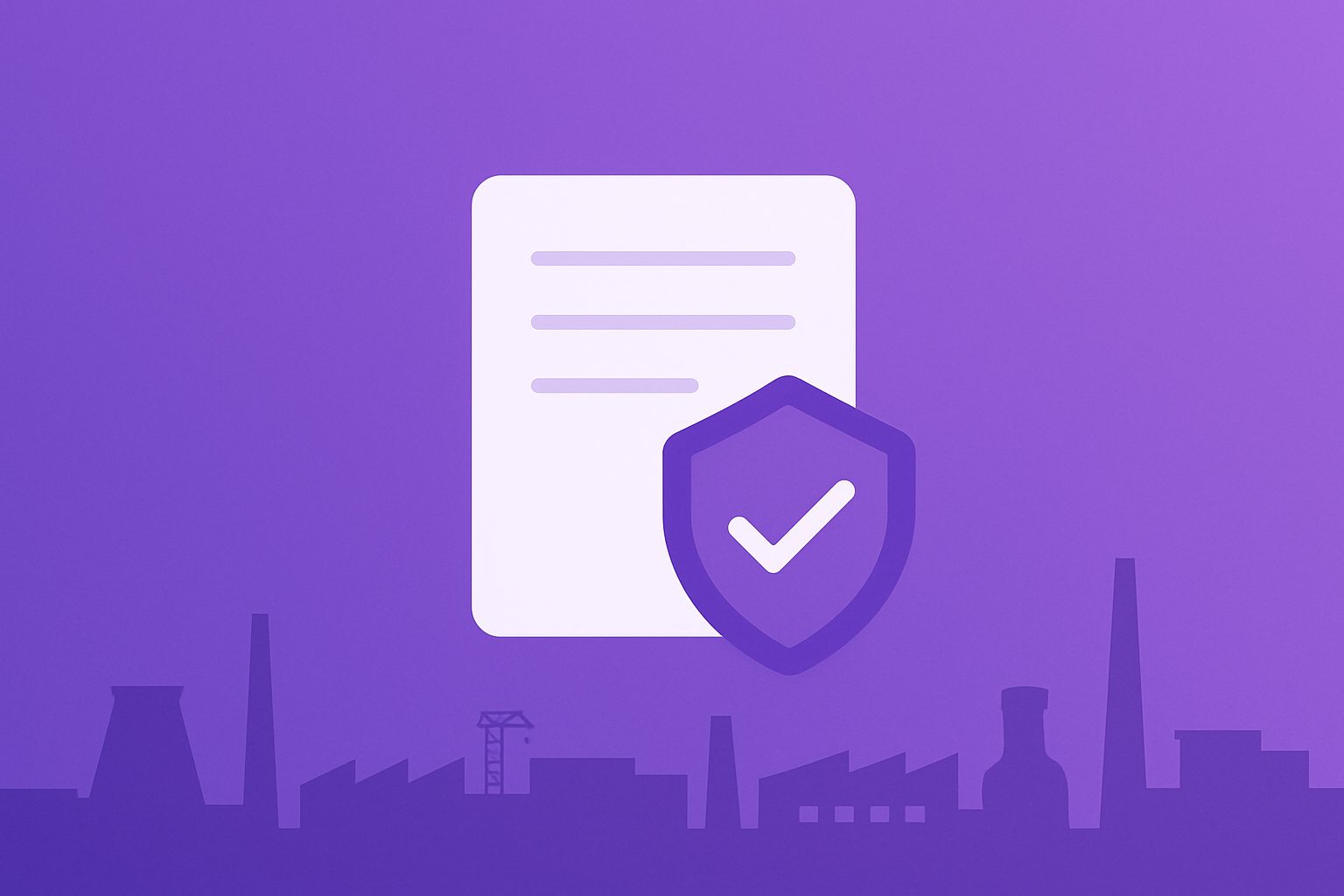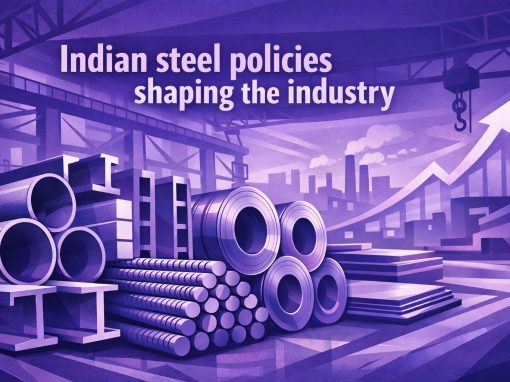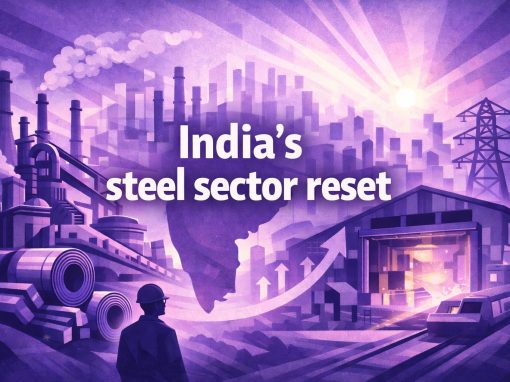Table of Contents
- MSME Survey Definition and Scope in India
- Key Purposes of MSME Surveys
- Key Survey Findings in Past Years – Challenges and Opportunities
- Types of MSME Surveys
- GOI MSME Survey Plans 2026
- How to Design and Conduct an MSME Survey
- Methodology, Compliance, and Ethics
- Limitations and How to Interpret Results
- Conclusion
An MSME survey is a planned way to get information about India’s micro, small, and medium-sized businesses. It tells you who these businesses are, what they make or do, where they work, how many people they hire, how they pay for their operations, and what problems they face. Policymakers, lenders, industry groups, and marketplaces use these results to make plans for programmes, credit lines, cluster support, and more to help MSMEs grow.
Let’s go into more detail about this subject so you can better understand why an MSME Survey is good for your business.
MSME Survey Definition and Scope in India
An MSME Survey typically contains a set of questions asked to a sample of MSMEs, to understand their sector better. The scope usually spans both registered and unregistered units, in urban and rural areas, across manufacturing and services. Government agencies, industry associations, banks, and research firms run such surveys at national, state, or cluster levels, sometimes for the whole sector and sometimes for themes like credit, technology, exports, or logistics.
These surveys can be conducted online, on the phone, or in the field. Typical respondents are owners, partners, directors, plant managers, finance or accounts heads, and sometimes HR or operations leads who know employment, turnover, inputs, and markets.
Survey Vs. Census Vs. Administrative Data (Quick Comparison)
| Feature | Survey | Census | Administrative Data |
| What it is | Data from a selected sample of units. | Enumeration of all businesses in a group. | Records created during service delivery or compliance. |
| Coverage | Sample only, designed to represent the population. | Complete or near complete within the frame. | Only entities interacting with a system or law. |
| Frequency | Periodic or ad hoc. | Infrequent, large exercise. | Continuous, updated as transactions occur. |
| Strengths | Rich variables can capture attitudes and constraints. | Full counts, strong small-area totals. | Timely, large volume, low collection cost. |
| Limits | Sampling error, recall bias. | Costly, slow to update. | Coverage gaps, definitions vary across systems. |
| India examples | National sample rounds, state or cluster studies. | Economic or enterprise census. | Udyam registration, GST, MCA-21, EPFO, GeM, bank credit files. |
Key Purposes of MSME Surveys
Policy Design and Targeting
- Find who needs help most: Identify sectors, sizes, and regions where MSMEs face the toughest problems.
- Set fair rules and budgets: Use data to choose which schemes to launch and how much money to allot.
- Measure impact over time: Create a baseline so future surveys can show what improved and what did not.
Credit Access, Supply chain, and Market Linkages
- Spot credit gaps: Learn who gets loans, who is rejected, and why (collateral, documents, interest cost).
- Track cash cycles: Map payment delays from buyers and how they affect working capital for MSMEs.
- Improve market reach: See how MSMEs sell today (local, online, export) and what blocks wider access.
Employment, Skill Gaps, and Productivity Tracking
- Count jobs and roles: Capture total workers, women’s participation, and contract vs. permanent staff.
- Find skill shortages: List skills in demand so training can be planned with ITIs and skilling bodies.
- Raise output per worker: Note common issues like machine downtime, rework, or energy cost that reduce productivity.
Technology Adoption, Quality Certification, Sustainability
- Map digital use: Check adoption of e-invoicing, GST tools, ERP, and simple automation on the shop floor.
- Push quality standards: Track certifications like ISO, BIS, and sector marks that open premium markets.
- Support green practices: Record steps like energy-efficient motors, solar use, and waste recycling.
State and District Planning, Cluster Development
- Plan local infrastructure: Show needs for power reliability, roads, warehousing, testing labs, and tool rooms.
- Build common facilities: Identify clusters that benefit from shared machines, heat treatment, or packaging centers.
- Simplify permissions: Flag paperwork pain points so single-window or online approvals can be improved.
Export Readiness and Compliance
- See who is ready to export: Find MSMEs with exportable products, capacity, and basic documents.
- Spot common hurdles: Note issues like HS codes, customs paperwork, packaging, and quality norms.
- Guide with support: Point to needs like IEC, logistics help, trade fairs, and buyer discovery.
Formalisation and Ease of Doing Business
- Find paperwork pain: List forms, inspections, and approvals that take the most time or cost.
- Suggest fixes: Highlight where single-window, online filing, or simpler rules can help.
Key Survey Findings in Past Years – Challenges and Opportunities
MSME Challenges (Seen Often Across India):
- Credit is hard to get: Many MSMEs still face collateral demands, high interest, and long approval times.
- Payment delays hurt cash flow: Buyers pay late, which blocks working capital and slows MSME growth.
- Low formalisation: Some units are outside Udyam, GST, EPFO. This limits access to loans and schemes.
- Heavy compliance load: Multiple filings and inspections take time and add cost.
- Technology gaps: Limited use of ERP, automation, and digital tools reduces efficiency.
- Skills mismatch: Workers need training in quality, maintenance, safety, and digital tasks.
- Infra and logistics costs: Power cuts, high freight, and weak last-mile options raise unit costs.
- Quality and export hurdles: Standards, testing, packaging, and paperwork remain pain points.
Opportunities (Growing Quickly):
- Rise in Formalisation: Udyam, GST, and e-invoicing are creating a clean data trail that improves lender trust.
- Digital finance: Invoice discounting, TReDS, and cash-flow based lending are improving access to credit.
- Market linkages: GeM, e-commerce, and B2B marketplaces are helping MSMEs reach new buyers and regions.
- Cluster support: Common facility centres, testing labs, and shared machines are improving productivity.
- Skilling and upskilling: Short courses with ITIs and sector bodies are closing critical skill gaps.
- Quality and certification: ISO, BIS, ZED and buyer audits are opening premium markets and exports.
- Sustainability wins: Energy-efficient motors, solar, and waste-reduction are lowering costs and meeting buyer requirements.
Types of MSME Surveys
National or Government-led Surveys (High Level)
Large public studies look at MSMEs across India. Samples often cover both registered and unregistered units. Common examples include national enterprise surveys, ministry-backed cluster diagnostics, and analysis of administrative records such as Udyam and GST. These exercises help set policy, measure scheme reach, and track changes over time.
Industry Association and Chamber Surveys
Trade bodies run quick polls and thematic studies. Chambers ask members about credit, orders, exports, logistics, and compliance. Results give a fast view of what is happening on the ground in sectors like engineering, textiles, food processing, and services.
Academic and Think-tank Studies
Universities and research institutes conduct field surveys with clear methods. They study productivity, technology use, skills, supply chains, and finance. These studies often compare districts, show what works, and suggest simple actions that firms and governments can take.
Private Sector and Platform Surveys
Banks, NBFCs, rating agencies, and data firms publish MSME insights based on customer records and interviews. Marketplaces and logistics platforms share trends on orders, payment cycles, and delivery times. These reports are timely and useful for business decisions.
Examples of Surveys
| Survey | Objective | Sample | Key result |
| 1 | To understand payment delays and cash flow | 500 MSMEs across six states | Median payment time: 60 days. Firms using e-invoices saw shorter delays and fewer disputes. |
| 2 | To map the use of technology on the shop floor | 300 manufacturing MSMEs in three clusters | Barcode inventory and basic ERP cut stockouts and improve productivity within three months. |
| 3 | To check export readiness in light engineering | 200 firms with steady domestic sales | Many had buyers but lacked HS codes, packaging standards, and one quality certificate. A short checklist closed these gaps. |
GOI MSME Survey Plans 2026
A new, government-led MSME survey is being planned for 2026 to track ease of doing business for MSMEs. Early reporting says it will look at finance access, default patterns, enterprise conditions, exports, and use of online channels. The goal is to give a clear picture of MSME health so that effective guide policies can be implemented to promote their growth.
The proposed MSME Survey is likely to draw on official databases such as GSTN, MCA-21 and Udyam to build or validate the frame, a direction MoSPI has already tested in its services-sector pilot.
India is also moving towards a more frequent and richer enterprise data. In 2026, watch for an official survey of incorporated service-sector enterprises to start, alongside the existing annual and new quarterly surveys of the unincorporated MSME universe. Administrative data like Udyam, GST, MCA-21, EPFO and GeM will continue to complement surveys and fill coverage gaps
The Three Expected Building Blocks for MSME Surveys in 2026:
- ASUSE/QBUSE for unincorporated enterprises (manufacturing, trade, other services).
- ASSSE for incorporated service enterprises beginning January 2026.
- Admin data streams (Udyam, GSTN, MCA-21, EPFO, GeM) to validate and deepen estimates.
Implications for State Departments, Banks, and MSME Clusters
- States can target cluster support, tool rooms, testing labs, and logistics fixes using quarterly red flags instead of waiting a year.
- Banks/NBFCs can blend survey trends with Udyam/GST trails to sharpen cash-flow lending and early-warning signals.
- Clusters and associations can use local slices of the data to plan short trainings, quality certification drives, and digital adoption sprints tied to real bottlenecks surfaced in the quarterly bulletins.
How to Design and Conduct an MSME Survey
Define Objectives and Target Group
Make sure the survey has one clear goal. You can figure out who your MSME audience is by looking at their activity, size, registration, and location. List what you don’t want to see at the beginning so that the results are easy to read and compare.
Choose a Sample and a Size
Choose a sampling method that fits your frame: simple random for clean lists, stratified for state or sector cuts, and cluster sampling for field efficiency. Find out how many responses each stratum needs by figuring out how big the sample sizes should be.
Design Questionnaire
Keep it short and modular. Use core blocks like profile, finance, markets, jobs, technology, and challenges. Add skip logic so respondents only see relevant questions. Use plain language, fixed recall periods, and standard codes (e.g., Udyam, GST).
Run a Pilot Test
Train interviewers on definitions, consent, and probes. Set daily quotas, call-backs, and spot checks. Track progress with a simple dashboard showing completes, refusals, and QA flags.
Check Data Quality and Control for Bias
Use in-form validations, range checks, and required fields. Add back-checks and audio notes to a small sample. Watch for non-response bias and over-representation of easy-to-reach units; make edits if needed.
Clean, Analyse, Dashboard
Check that all the codes are the same, fix any missing data, and write down every change. Prepare key indicators and crosstabs in advance. Send state teams, banks, and clusters a short note, a PDF with charts, and a simple dashboard so they can get to work right away.
Topics to Cover in an MSME Survey Questionnaire
A well planned MSME Survey template helps you collect the right MSME facts, fast. It is simple, modular, and ready for field use or phone, online, in field surveys.
Business Profile and Registration
Understand who the enterprise is and where it operates: Udyam, GSTIN, PAN, activity, product/service, state, district, and cluster details.
Employment and Wages
Record total workers, permanent vs. contract, women’s participation, apprentices, and typical monthly wages. Note EPFO/ESIC status and safety training.
Revenue, Orders, Working Capital
Log last-year revenue, YTD sales, buyer types, order size, delivery time, payment terms and actual DSO. Add working-capital source and interest rate.
Input Costs, Energy, Logistics, Credit
Track input cost pressure, energy source and outages, logistics mode and freight cost. Note active loans, lender type, collateral, and recent credit rejections.
Technology Use, Certifications, Sustainability
Assess e-invoicing and on-time GST filing. List ERP or accounting tools, inventory tracking, MRP. Record ISO/BIS/ZED and simple green actions like efficient motors or solar.
Constraints, Policy asks, Future Plans
Ask for top three bottlenecks, key policy requests, and next-12-month plans on revenue, hiring, capex, and exports.
Methodology, Compliance, and Ethics for MSME Surveys
Getting Permission and Keeping Information Private
Start every interview with a short consent script. Let people know who you are, why you are collecting information, how it will be used, and that they don’t have to take part. You can get permission by using the app or writing it down. If you don’t need them, don’t ask for names. Use a random code or an ID like Udyam instead. Don’t mix up your answers with your personal information. Get the data out before you start looking at it. Set a clear time limit for keeping things, like 12 to 24 months after they are published, and then safely delete or archive them. Don’t give out totals or results with names on them.
Indian Privacy and Data Protection Context
Follow the Digital Personal Data Protection Act of 2023. Only collect what you need, use it for the purpose you said you would, keep it accurate, and let people change their minds or fix their information. Write down the name of someone you can call if you have a problem in your survey note. If you hire someone to host or call, make sure they sign a simple contract that says how they will use your data. Watch out for any GPS, financial, or contact lists. If you work for the government, you should read the CERT-In advisories and the ministry’s rules about security.
Secure Storage, Audit Trail, Enumerator Code of Conduct
When you’re not using or sending data, keep it on approved systems and encrypt it. Limit access to certain things based on a person’s role, use strong passwords, and turn on two-factor login. Write down the interviewer’s ID, the time, the place where you checked in (if you were allowed to), and any changes that were made with explanations. Do back-checks on a small number of people who work for you. Tell the enumerators to respect people’s privacy, ask questions exactly as they are written, never use language that leads or coerces, never promise benefits, and always report mistakes right away. People trust you more when you’re professional, and the data is better.
Limitations of MSME Surveys and How to Interpret Results
Sampling and Non-response Limits
A survey studies a sample, not every MSME. Some types of firms may be harder to reach, and some may choose not to respond. This can tilt results. Use design weights, report the margin of error, and check who is missing by size, state, or activity. Treat small subgroup numbers with care.
Period Effects and Seasonality
Findings reflect the months when interviews happened. Festive peaks, monsoon, price spikes, or policy changes can move numbers up or down for a short time. Compare states and sectors from the same period, and where possible use year-over-year or moving averages to see the true trend.
Triangulation with Administrative Datasets
Cross-check survey results with Udyam, GST, EPFO, MCA-21, and GeM. Use these sources to verify counts, improve weights, and validate patterns in jobs, sales, and payments. Note that definitions and coverage differ across systems, so explain any gaps clearly and keep privacy rules in place.
Conclusion
MSME surveys give a clear picture of how small businesses work and what they need. Findings from MSME questionnaires guide better policy making, credit access, markets, skills, and technology. Read results carefully, since samples, timing, and non-response can affect numbers. Cross check trends with Udyam, GST, EPFO, and other records. Define goals, use a short questionnaire, and turn insights into quick actions.
Empowering MSMEs to grow smarter
Tata nexarc delivers powerful solutions for MSMEs—discover tenders, logistics solutions, and streamline procurement. Everything your business needs, all in one place.
FAQs
What is an MSME Survey?
What is the difference between an MSME Survey and an MSME Census?
Who runs MSME Surveys in India?
How are MSMEs classified in India?
How is a survey different from a census and administrative data?
How are respondents selected for an MSME survey?
What topics does a good MSME questionnaire cover?
How are consent and privacy handled with an MSME Survey questionnaire?
How often are results for MSME Surveys released?
How should results for MSME studies be interpreted?
A product manager with a writer's heart, Anirban leverages his 6 years of experience to empower MSMEs in the business and technology sectors. His time at Tata nexarc honed his skills in crafting informative content tailored to MSME needs. Whether wielding words for business or developing innovative products for both Tata Nexarc and MSMEs, his passion for clear communication and a deep understanding of their challenges shine through.












